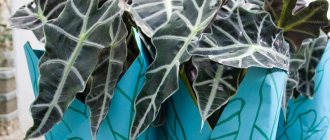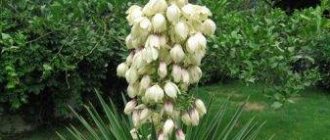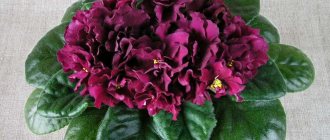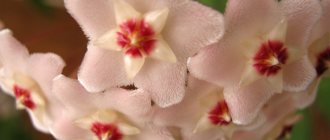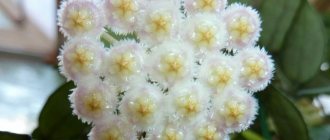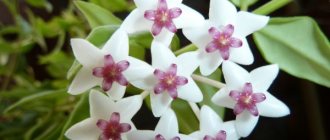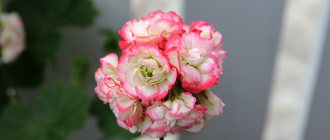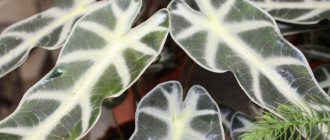Alocasia is a tropical perennial plant from the Araceae family. It grows wild in Southeast Asia (mainly Malaysia and Sri Lanka). In total, according to various estimates, there are about 50-70 species, but not all are suitable for growing at home.
One of the most successful varieties for indoor floriculture is Alocasia Dragon, a short but very beautiful plant. Below we will discuss the features of this species and the rules for caring for this rare tropical plant.
Detailed description and photo
Alocasia Dragon is a rather rare variety, but at the same time very spectacular. Its full name is Alocasia Dragon Scale, but in everyday life it is often called “dragon skin.” And indeed, a certain similarity is noticeable - the oval leathery leaves are dotted with veins pressed into the surface (they create a convex pattern on the underside of the plate).
This texture itself resembles dragon wings. And at the same time, the leaves have an unusual color - the plate has a lighter shade, from silver to pale green, and the veins stand out in a dark color.
Like other varieties of Alocasia, Dragonskin is a tuberous plant. Its leaves have succulent petioles and watery mouths-hydathodes. In nature, these plants love humidity, but excess moisture still needs to be removed, especially during the rainy season when the soil is oversaturated with it. This is what hydathodes are for.
It is interesting that the hydathodes act as a barometer - on the eve of rain, moisture is removed from them, and the plant seems to “cry”.
Alocasia - description of the plant
Alocasia (Alocasia) from the Araceae has received the eloquent nicknames “elephant”, “elephant ears” and “African mask” for the size and shape of its leaves.
Alocasias in rooms rarely exceed 1 m in height and almost always retain their leaves for the winter. They are evergreen large-leaved stars with a thick, short, upright stem and a stolon-like or tuberous rhizome. Usually on one plant with good maintenance you can admire 6-8 leaves. The plant produces about one leaf per month.
The leaves are very large, lobed, thyroid-shaped, densely leathery, from 20-30 cm to 80 cm in length, on powerful petioles 30-100 cm high with long sheaths. The unclear shape and color of young leaves change to arrow- or heart-shaped with very large teeth along the edges - in adults. The strong gloss of the leaves emphasizes the wavy curves of the surface.
In some species the color is light and monochromatic, in others it is almost black with thick contrasting veins. The pattern of the veins is special: the petiole is divided into three central veins (the main and lateral segments), and the secondary veins create a feather pattern, merging into the marginal border. The leaves have hydathodes - water stomata that secrete drops of water when waterlogged.
Alocasia rarely blooms in rooms. The inflorescences are hidden in the mass of leaves, not exceeding the petioles in height. The greenish-colored cobs are hidden by a blanket with a slight constriction. Half-balls of red berries are an even rarer sight.
Alocasia, especially the rhizomes, must be handled very carefully. Toxic substances can cause serious irritation and poisoning.
How is it different from other types?
The main difference is the relatively small height with rather large and heavy leaves. The height of this plant in nature reaches 1 m, but at home it rarely grows above 50-60 cm.
Young foliage usually has a more even green color, but gradually lighter and darker areas appear on it, the veins become more pronounced, which gives the blades a leathery appearance.
Their petioles are not as long as other varieties. Over time, they can bend greatly under the weight of the leaves. This forms the recognizable silhouette of the flower.
The large leaves of Alocasia Dragon require quite a lot of space, so a windowsill for this plant is not the best option . Moreover, it does not tolerate drafts well. The ideal option would be a florarium, but the florist does not always have such an opportunity. Therefore, a small kitchen space is also suitable, provided that there is no air conditioning.
Alocasia odora
This species has a height of about two and a half meters. The shoots grow vertically, form shortened stolons arising from the main stem and growing tuberous processes. Leaves grow on the tops of shoots in adult specimens, grouped in groups of several. The leaf plate is attached to a petiole one and a half meters long, has a leathery structure, an arrow-heart-shaped or oval configuration, a length of 130 cm and a width of a meter. The edges are wavy, the end is sharp, the color is deep green. The surface of the leaf is covered with clearly defined veins. It blooms in inflorescences that form in the axils of the leaves in pairs and are attached to strong long stalks. The length of the peduncle is 30-35 cm. The spathe is about 20 cm long, green-bluish in color. The cob is supported on a shortened stalk and is shorter than the spathe. At the end of flowering, berry-shaped fruits with a circumference of 1 cm are formed, which, when fully ripened, acquire a pink color. This species is found in China, Thailand, Taiwan, Japan, India, Sri Lanka, Vietnam and Cambodia. Prefers to be grown in tropical shaded forests or limestone cliffs. In some countries it is used as a medicinal plant for cholera and abdominal pain. The juice of the leaves is used externally after snake bites.
Varieties
Dragon Scale is the common name of the species. However, depending on the shade of the leaves, two varieties are distinguished.
Alocasia Silver Dragon
It is distinguished by silvery leaves and dark veins.
Alocasia Pink Dragon
A rare variety with dark leaves, light veins and pink stems.
It is interesting that the cost of these varieties in different stores and garden centers can vary dramatically, but the “pink dragon” always costs more.
3.Types of alocasia:
3.1.Alocasia Polly or Amazonian - Alocasia sanderiana
A very attractive decorative foliage, evergreen plant with dark green, curly leaves on long basal petioles. The leaf blades are covered with veins highlighted in a lighter shade.
↑ Up,
3.2.Alocasia macrorrhizos
This species has glossy, bright green, heart-shaped leaves. The leaf blades are soft and have beautiful corrugated edges. Thick leaf petioles reach a length of 90 cm.
↑ Up,
Medicinal properties
In folk medicine, alocasia remedy is considered useful for tuberculosis and pathologies of the respiratory system, as well as for cancer. Wound healing and anti-inflammatory compresses are often made from the leaves.
Scientists are currently studying the medicinal potential of alocasia. So far, official medicine has not proven that it has healing properties. But given the fact that it contains vitamins, as well as flavonoids (for example, dihydroquercetin), its anti-inflammatory properties can be confirmed. In addition, it is possible that alkaloids like vinblastine contained in the leaves have an antitumor effect.
Alocasia navicularis
This evergreen herbaceous plant is about one and a half meters high and contains milky juice in its leaves. Shoots growing vertically or lodging. Leaves grow in bunches and form at the ends of mature specimens. The leaf blades are attached to long one and a half meter petioles. They have an oval-heart-shaped configuration, 130 cm long and 120 cm wide. They bloom in pairs in the leaf axils. The flowers are attached to long stalks, which have a strong structure and are about 45 cm long. The bedspread has a dark yellow color. The cob is smaller in size than the spathe and has a white color. It produces fruits of an oval configuration, dark red in color, up to a centimeter long and about 6 mm in circumference. It is found in many Asian countries, in rocky places, at an altitude of more than 1500 meters above sea level in vain.
Bloom
In all types of alocasia, the inflorescences are not particularly decorative. The main decoration of the plant is the leaves. And in this variety they are especially good.
When and how?
Alocasia rarely blooms, but usually occurs between July and September.
The inflorescence is shaped like an ear. It has a pale white-pink hue.
The inflorescence consists of many small flowers. On one side it is covered with a rather dense sheet of cover.
What do the fruits look like?
After flowering and pollination, fruits are formed, which are oblong berries of a rich reddish-brown color with seeds inside.
Alocasia macrorrhizos
This species has a height of more than 2 meters, consists of petioles about a meter long. It has spherical, ovate leaves that are formed from diverging lobes. The leaf is about a meter long, 80 cm wide. The color of the leaves is green. Light green veins are clearly visible on the leaf plates, the surface of the leaf is glossy. Leaves grow from a basal rosette. It blooms with yellow flowers, on short stalks 30 cm long. The spadix and spathe are the same length. The fruits are bright red glossy berries containing 2-3 dark brown seeds.
Where and at what price can I buy it?
You can buy an adult plant in a store or on the Internet (by advertisement). The first option is more preferable, since this gives the buyer more confidence that he is buying a healthy plant of the desired variety.
- The price of Silver Dragon is on average 1300-1400 rubles .
- Pink Dragon costs more - from 1500 rubles .
Where can I get planting material?
The plant's seeds are practically not sold, but seedlings can be purchased at a garden center or by advertisement. The price will be approximately the same - 250-300 rubles per seedling.
Application of tincture
An alcoholic infusion of petioles and leaves can be used externally for rubbing or as a compress. It is believed that he can:
- help with inflammation and swelling;
- starts the process of tissue repair;
- reduces joint pain.
Alocasia tincture is prepared by grinding the plant in a ceramic bowl. Metal tools are not used. The ratio of ground pulp and alcohol is 1:1. The resulting solution is stored in the dark for 21 days.
Attention! Ingestion drop by drop, the amount of which is determined by a doctor who knows the dosage. Considering that this type of plant is not recognized as medicinal, and the juice contains mercuric chloride and cyanides, the treatment is questionable.
Landing
In order for the plant to develop well, planting must be carried out according to all the rules.
Choosing a pot
The growing container is chosen taking into account the fact that Alocasia Dragon has an elongated rhizome.
Also, the pot must be very stable , since the leaves have a significant weight.
And of course, it should have drainage holes in the bottom.
What should the soil be like?
This plant prefers slightly acidic soils with a pH of 5.5-6.0. For it, you can choose special soils that are intended for representatives of the Aroid family.
In stores you can find soil for spathiphyllum or dieffenbachia - you can also buy it for alocasia.
Let's get down to business
When planting seeds, the algorithm of actions will be as follows:
- after collection, the seeds are planted in a light substrate and the container is covered with plastic film, making a kind of greenhouse;
- after germination, pick when a pair of true leaves appear and when the sprout reaches 10 cm;
- for about a year, until large leaves appear, the seedlings are kept in a mini-greenhouse to ensure the proper level of humidity;
- After large leaves appear, the plant is transplanted into a pot, at the bottom of which a drainage layer of expanded clay is placed.
When growing alocasia from cuttings, the algorithm will be generally similar, only first the cuttings are rooted in a nutrient substrate and kept in Kornevin’s solution.
Reproduction methods
Growing from seeds
Flower growers grow from seeds only those species and varieties of alocasia whose foliage has a uniform color. When growing variegated forms from seeds, there is a high probability that the emerging seedlings will not retain the varietal characteristics of the mother plant. Fill the container with a soil mixture consisting of peat and sand (1:1), the seeds are distributed over its surface and only slightly pressed into the substrate. The crops are covered with film (glass) on top and placed in a warm (about 24 degrees) place. Provide the crops with regular watering and ventilation. The emerging seedlings, after they have grown stronger, dive into separate pots. And when the plants grow up, they are planted again in pots up to 70 mm in diameter. After the root system of a young plant becomes very crowded, it is transferred to a larger pot and begins to be cared for as an adult flower.
Vegetative propagation
Alocasia can be propagated from various parts of the bush. However, no matter which part you choose, the cut points on the rhizome or cuttings must be treated with crushed charcoal. For rooting, they are planted in a substrate containing peat and sand (1:1). The container in which part of the bush was planted should be covered on top with a film, bag or glass; it should be provided with systematic watering and ventilation. In order for rooting to be successful, the air temperature should be maintained at a level of 22 to 24 degrees. When the first shoots appear, the bush is transplanted into a temporary container, and after it gets stronger and its roots grow, it is transferred to a permanent pot.
Alocasia: propagation and resuscitation of a discounted plant. Part 1
Caring for a plant at home
In general, they care for the “dragon” in the same way as other types of alocasia, because it loves warmth and moisture in the same way.
Temperature
Temperature is very important for this plant. Even in winter, the room must be at least +16°C, otherwise the alocasia will begin to dry out after some time.
Lighting
You need to take care of intense but diffuse lighting.
Attention! The flower should not be left in bright sun, as this may cause the leaves to burn.
Watering
Alocasia is a plant native to the humid tropics, so at home it also requires high air humidity. And the soil must always be moist. But this effect is achieved not due to the abundance of watering, but solely due to its frequency. Only in winter, when the dormant period begins, can the frequency of watering be reduced.
In addition, it is advisable to periodically spray the leaves of alocasia . Soft water is suitable for this purpose, which is pre-heated slightly so that it is slightly warmer than room temperature.
Top dressing
For alocasia, it is recommended to use dry complex fertilizer. It is laid in a layer at the bottom of the pot when planting the plant. If this is not possible, then you need to feed the plant with liquid fertilizer intended for deciduous indoor flowers. From spring to mid-autumn this is done every two weeks. In winter, fertilizing is not carried out.
Trimming
Cleaning pruning is carried out as necessary to get rid of dried leaves.
Transfer
An adult plant is replanted no more than once every three years, a young plant - as it grows.
Care during the flowering period
Experienced gardeners recommend removing inflorescences , since they take resources from the leaves - the main decoration of alocasia. The place where the flower is cut is treated with crushed charcoal for disinfection.
What to do if the buds don't appear?
There is no need to make any effort for the plant to bloom. The main thing is to take care of the leaves.
Reproduction
This plant can be propagated by both seeds and cuttings, division of rhizomes and nodules. Propagation by cuttings is considered the easiest way.
Specifics of care
How to water a plant
Alocasia, as a native of the tropical forest, is very moisture-loving. During the warm season, it requires abundant watering every other day. But under no circumstances should water accumulate in the pan. Alocasia also reacts positively to leaf moisture. Daily spraying will only benefit her.
In winter, watering should be reduced. The amount of water a plant needs is directly proportional to the thermometer reading. The frequency of watering is equal to the time it takes for the surface of the substrate to dry to a depth of 1 cm. In dry climates, spraying should be continued. However, it is advisable to do this only in the morning hours of sunny days.
Important! The best effect is achieved by watering with softened (settled or boiled) water. For winter watering you need water heated to 20 degrees. Not only drying out of the soil, but also its soaking can be fatal for alocasia.
Top dressing
The optimal regime for fertilizing alocasia with organic or complex mineral fertilizers is evenly, with an interval of 14–15 days during the period of active growth (April - September). The plant gratefully accepts complex fertilizers intended for decorative deciduous plants.
Complex fertilizers are suitable for alocasia
Important! The dosage of fertilizers is taken at half the amount specified by the manufacturer.
In winter, fertilizing should be reduced to once a month.
Bloom
Not everyone has seen alocasia bloom, because it blooms extremely rarely. At the same time, it begins to intensively shed its beautiful leaves. To prevent this process, you can go in two ways:
- cut off the resulting peduncle, preventing the flower from opening, and sprinkle the cut with charcoal powder;
- Allow the alocasia to bloom by feeding it with fertilizers for flowering plants.
The faded peduncle must be cut off so as not to further deplete the plant by ripening the berries.
Rest period
This period is weakly expressed in Alocasia. It’s just that with the onset of cold weather and decreasing daylight hours, it grows leaves less intensively. The gardener’s task during this period is to moderate watering and fertilizing.
What to do if problems appear with the plant?
Alocasia is quite picky and can “show character” under inappropriate conditions. To preserve the beauty of a plant, it is necessary to correctly and timely respond to a signal about a problem, knowing why this or that phenomenon occurs. Let's decipher the most common of them in the table.
Problems of caring for alocasia - table
| Signs of erroneous care | Causes | Ways to fix errors |
| Slow development during the growing season. | Lack of nitrogen. | Feed with nitrogen fertilizers in a lower dosage (1 g per liter of water). |
| Lethargy of leaves. | Overmoistening or overdrying of the soil; unsuitable soil composition. | Replant and water according to the rules. |
| The edges of the leaves dry out. | Severe dry air. | Humidify the air more often using a spray bottle or other means. |
| Dark spots on leaves. | Blowing through drafts. Low temperature. Sunburn. | Move the plant to a protected place. Shade from direct sun. |
| Leaf fading. | Poor lighting. | Move to brighter light or provide artificial lighting. |
| Yellowing of leaves. | Drafts, temperature fluctuations. Watering with hard chlorinated water. | Move the plant to a protected place. Set aside or boil the water. |
| The plant has dropped its leaves. | Exhaustion of the plant by flowering. Malnutrition. | Remove the peduncle. Feed the plant according to the rules. |
| Drops of water appear on the leaf plates. | Excessive watering. | Pour water out of the pan. Allow the soil surface to dry. Water according to the rules. |
Manifestation of errors in caring for alocasia - photo gallery
Exhausted alocasia sheds its leaves
The result of improper watering and fertilization is the wilting of alocasia
Inadequate maintenance conditions harm the decorative appearance of the plant.
The result of hypothermia and improper watering is yellowing of the leaf plate
Diseases and pests
It happens that alocasia leaves stop growing and turn yellow, or white fluff appears at the base of the petioles - all these are symptoms of various diseases or pest damage.
For example:
- Yellowing of the leaves and the formation of a kind of cobweb on their underside is a spider mite.
- A white sticky coating at the base of the cutting is a mealybug infestation.
- Rotting of cuttings may indicate a fungal infection.
- Sometimes aphids appear on alocasia leaves. And if the room is warm, then the reproduction of such pests is especially active.
Important! Action must be taken urgently, otherwise the plant will die.
Possible difficulties when growing alocasia
- Plant growth usually slows down due to nitrogen starvation. Feed the plant with ammonium nitrate solution (1 g/l).
- New leaves do not grow within 6 months - you should consider replanting or fertilizing.
- The leaves turn pale and lose their colorful color due to lack of light. It is necessary to increase the lighting intensity gradually. In the autumn-winter period, it is a good idea to use additional lighting with a phytolamp for resuscitation. The tips of the leaves turn brown due to low soil or air humidity.
- Dark spots on the leaves appear when overcooling occurs due to low temperatures or drafts. Another cause could be a fungal disease.
- Leaves wither when the soil becomes too dry or waterlogged. Another reason may be that the substrate is too heavy, which must be immediately replaced with a lighter one, with perlite, sand or chopped sphagnum.
Photo: Rita Brilliantova
Treatment/control methods
Control methods depend on what exactly the grower is facing.
- Spider mites are mechanically removed from the leaves using a brush with stiff bristles, which is pre-moistened in a weak soap solution, then thoroughly washed with water.
- Mealybugs are removed from the cuttings with a cotton swab soaked in an alcohol solution, then the affected area is washed with water.
- When infested with aphids, the plant is treated with an appropriate chemical, for example Fufanon.
In case of severe mite infestation, it makes sense to use special chemistry - for example, Decis.
Prevention of various problems
Over time, the leaves inevitably turn yellow, but if green veins remain on them, and then they gradually dry out, this is a natural aging process. You just need to cut off such leaves. But if only the upper leaves turn yellow and dry out, this means that the air is too dry for the plant; you need to spray the alocasia with warm water more often.
If young leaves practically do not appear or grow small, this indicates that the plant requires feeding.
Alocasia Dragon is a beautiful indoor plant that will fit perfectly into any interior. The main thing is to follow all the rules for caring for it.
Air humidity
The first thing that is required to create optimal conditions for the flower to exist is to create the most humid air and organize moderate watering .
In summer, the optimal temperature for the plant is 22-26 degrees, in winter - at least 18-20 degrees.
It is necessary to ensure that there are no drafts or sudden changes in temperature - this has a detrimental effect on Alocasia.

